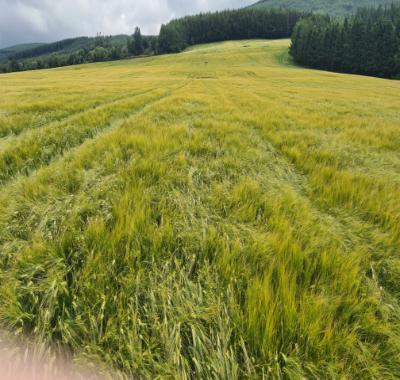Farm update July 2023
This update is penned on the 20th of July and there has been many challenges weather related all year long. February was the driest on record followed by March which was the wettest on record and June one of the hottest recorded. A wet March disrupted the Spring setting which was going to be a higher acreage than normal given the terrible weather in October 2022. Spring crops on lighter free draining land did better but the result of later setting following drought conditions has left many spring crops thin and with a reduced yield potential.
Spring Barley
I have an interesting mix of Spring barley. The two varieties are Amity and Gangway which suit my system given their enhanced ability to stand and their high yield potential. The 80 acres of Gangway set on heavy ground on the 4th of March was hammered with four weeks of rain which led to considerable headland damage. This crop received 2000 gallons of pig slurry early May which transformed it by delivering the nutrients required and keeping the tillers alive.
Yield Potential
Most of the Spring barley was set in early April and received slurry and fertilizer into the seedbed. The strong fertility helped the crop survive the prolonged drought. When rain arrived, the crop filled in quickly and displayed a strong green healthy leaf colour. I applied the herbicide/wild Oat control in mid-May and I also added 0.25 litres/hectare of generic Prothioconazole as the crop was very clean and advancing through the stages. The subsequent dry weather ensured that disease pressure was minimal, so I closed the gate and left the healthy crop fend off disease itself. This has proved successful with only a slight amount of ramularia coming in late on. The yield potential is excellent bar 15 acres which lodged following a storm in early July. I am confident that the application of organic fertilizer in the form of pig slurry on the growing crop in tandem with bagged fertilizer in the seedbed is contributing to a very healthy plant which is resilient to normal disease pressures.
Pest Management
The Winter beans are now starting to die off, with the lower pods black in colour. The later sown beans, sown in mid-November, seem to have better yield potential but both early and late sown crops have broken down from the July storms. The yield potential is excellent, and the crops are spotlessly clean from weeds which is notable given that they received no herbicide. The integrated pest management (IPM) cultivation prior to setting and ploughing down the beans is delivering good results.
This year, for the first time, I applied fungicide twice.
Chocolate spot appeared early in the season, so I applied Folicur on the 6th of April along with MnCuZn and I returned on the 29th of May with Kavator Plus and Basfoliar. I am pleased with the results, as the control areas with one spray were severely infected with Chocolate spot. I expect to harvest this crop from the 20th of August.
Winter Wheat Crops
Winter wheat crops were sown in early December 2022 following winter beans. I have two 40-acre blocks. The first block, which was disked early, grew a strong mat of volunteer beans which survived an application of glyphosate on the 15th of September. When the winter wheat was planted, I ploughed down a very strong green cover crop and this wheat crop preformed much better that the second wheat block which was set into bare ground. I was tormented by crows and weather, but I applied 30 units of Urea in early February and got the crops growing. The stronger fields received pig slurry on the 3rd of March but in the weaker 40 acres of wheat I waited until the 26th of April to apply pig slurry and the results were impressive. Both crops have received approximately 100 units of N per acre split in three applications. I applied Pacifica on the headlands to control brome and wild oats on the 15th of April and got really good results. The Axial Pro in the remainder of the field gave poor results and we hand rogued the fields later. A two-spray disease program was applied. Yield potential is good, and harvest will be mid-August.
Winter Barley
This is the first year in the last 30 years that I have no winter barley. The poor weather this harvest and the cost of growing this crop is discouraging me from growing it next year. Possibly a very good weather window in October may change my mind.
Cover Crops
The enhanced protein payment and the straw incorporation measures are very welcome again this year especially given the uncertainty of grain price. The ACRES scheme which I joined last year is a very practical scheme which will see me growing cover crops for the first time. Other measures I signed up for include overwinter stubble for the ground birds along with a percentage of minimum cultivation. The minimum cultivation should fit well into the ground post winter beans.
At this stage all tillage farmers are hoping for better weather to arrive. I wish everyone a successful and safe grain harvest.
